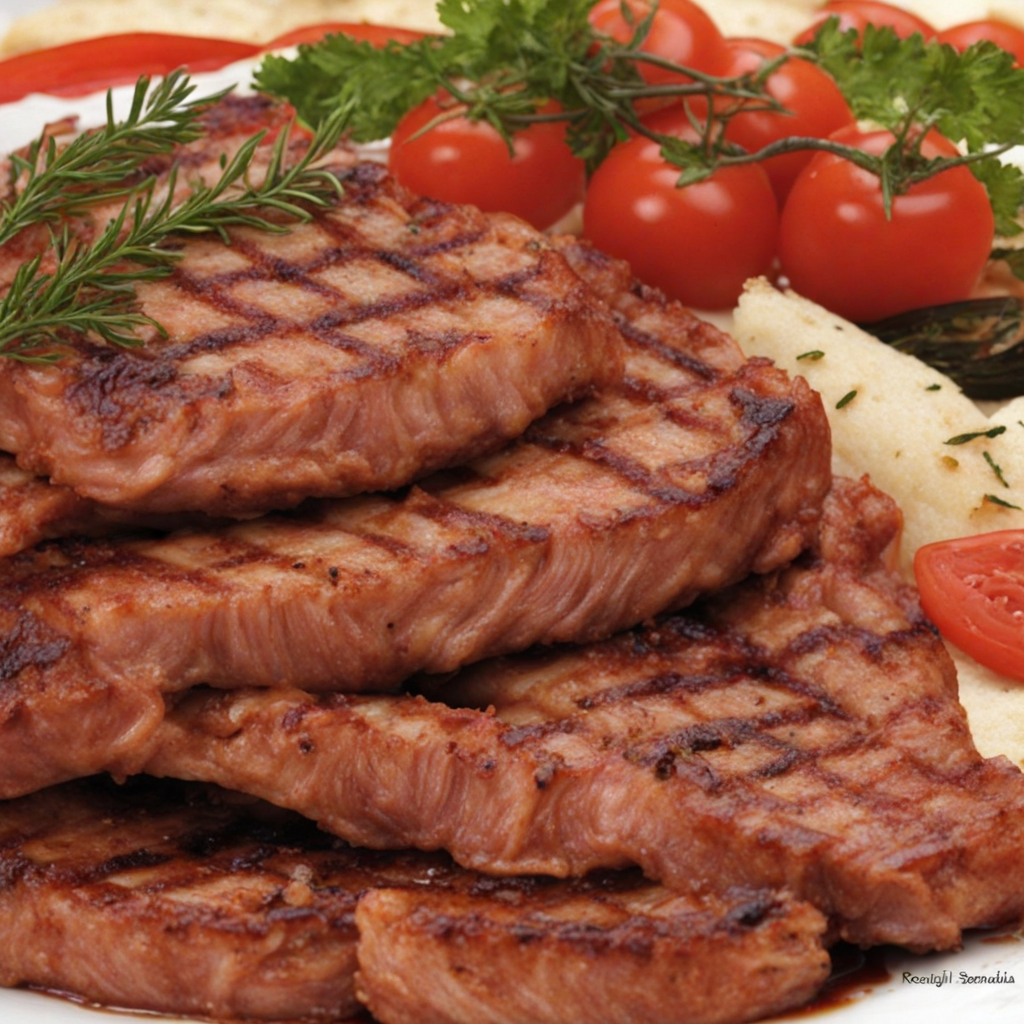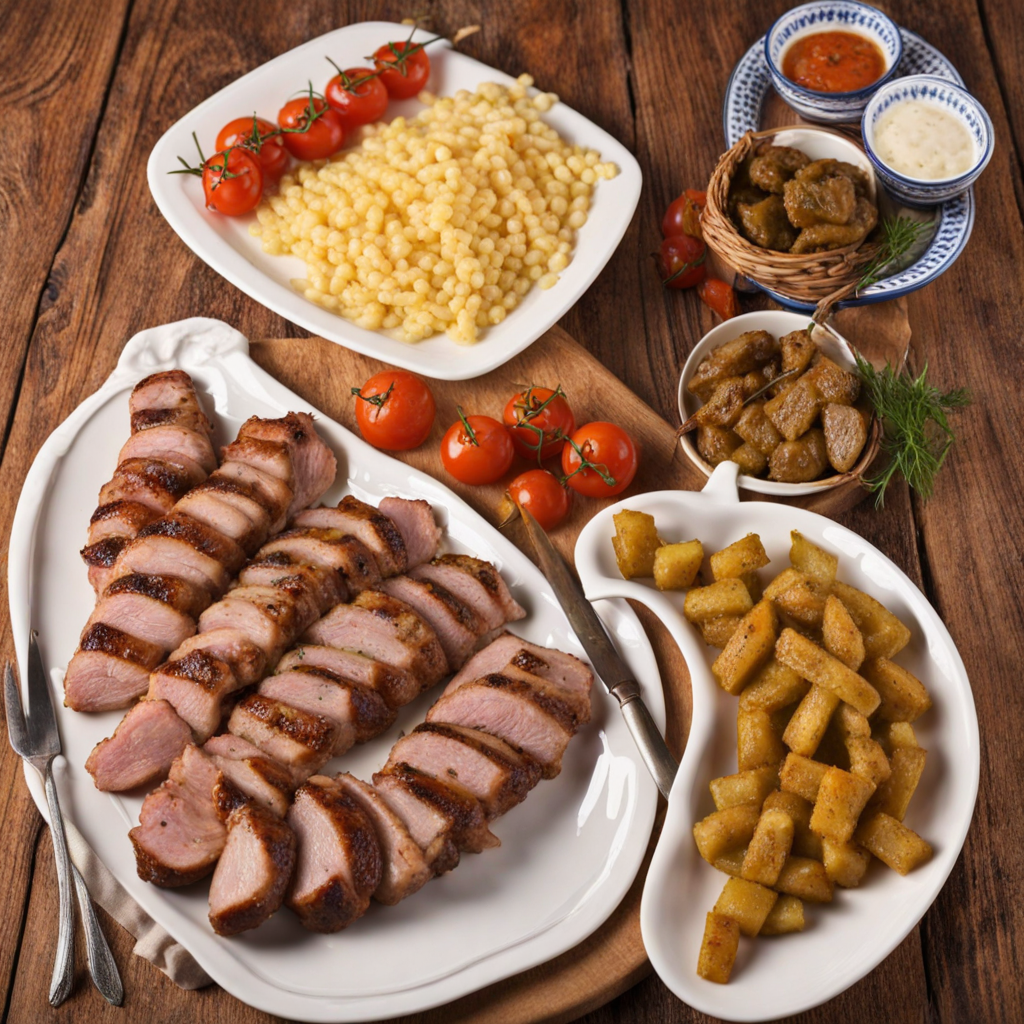Rostilj
Rostilj is a beloved Serbian culinary tradition that embodies the essence of outdoor grilling, often enjoyed during lively gatherings and celebrations. At its core, Rostilj features a variety of meats, predominantly pork, beef, and chicken, marinated and seasoned with a rich blend of spices. The meats are skewered or placed on the grill, allowing the smoky flavors to permeate the tender cuts. The process of grilling not only enhances the natural juices of the meat but also creates a tantalizing char that is irresistible. Accompanying the grilled meats are traditional condiments such as ajvar, a roasted red pepper and eggplant spread, which adds a vibrant kick to each bite. In addition to the meats, Rostilj often includes a selection of grilled vegetables, such as peppers, onions, and mushrooms, which provide a delightful contrast in flavor and texture. It is common to serve Rostilj with a side of fresh, crusty bread, perfect for soaking up the savory juices and adding a satisfying crunch. The meal is often complemented by a refreshing salad made of tomatoes, cucumbers, and onions, drizzled with olive oil and vinegar, balancing the rich flavors of the grilled meats. This combination results in a feast that is not only hearty but also vibrant and colorful, showcasing the bounty of Serbian agriculture. The experience of enjoying Rostilj goes beyond just the taste; it is a social event that brings friends and family together. The aroma of grilling meats wafts through the air, igniting an appetite and fostering a sense of community. This dish is frequently enjoyed with a glass of robust Serbian wine or rakija, a traditional fruit brandy, enhancing the flavors and making every meal a memorable occasion. Each bite of Rostilj tells a story of tradition, hospitality, and the joy of sharing good food with loved ones, making it an essential part of Serbian culture.
How It Became This Dish
The History of Роштиљ: A Culinary Journey Through Serbia #### Origins of Роштиљ Роштиљ, or “roštilj,” is a beloved culinary tradition in Serbia, emblematic of the country’s rich cultural tapestry and vibrant gastronomic heritage. The term refers to a variety of grilled meats, typically enjoyed in social settings, and it has become synonymous with outdoor gatherings, family celebrations, and festive occasions. While its origins can be traced back to the broader Balkan region, the specific characteristics and preparations of roštilj have evolved distinctly within Serbian culture. The practice of grilling meat has ancient roots, dating back to prehistoric times when early humans discovered the benefits of cooking over an open flame. This primal method of food preparation transformed meat into a more palatable and digestible form, setting the stage for its prominence in various cultures. In the Balkans, grilling became integral to communal dining, reflecting the social nature of food in the region. Historical records indicate that the tradition of roasting meats over an open fire was prevalent among the Slavic peoples, with evidence of similar practices found throughout Eastern Europe. By the Middle Ages, the consumption of grilled meats had become deeply entrenched in Serbian society, particularly among shepherds and farmers who relied on this method for cooking in rural areas. #### The Cultural Significance of Роштиљ Роштиљ is more than just a meal in Serbia; it is a social event and a symbol of hospitality. The act of grilling meats often brings families and friends together, fostering a sense of community and togetherness. It is common to see a roštilj at gatherings, from family picnics to festive celebrations, where the aroma of sizzling meats fills the air, enticing both the senses and the spirit. In Serbian culture, food is a central element of hospitality, and offering grilled meats to guests is a gesture of warmth and generosity. Traditional roštilj often includes a variety of meats, such as ćevapi (grilled minced meat sausages), pljeskavica (seasoned beef patties), and ražnjići (skewers), each of which carries its own story and regional variation. Accompanied by fresh bread, salads, and traditional condiments like ajvar (pepper-based relish), the meal becomes a tapestry of flavors that reflects the agricultural bounty of the land. The importance of roštilj is also evident in Serbian festivities and celebrations, where it often takes center stage. Events such as weddings, birthdays, and holidays are marked by the presence of grilled meats, emphasizing the role of food in creating lasting memories and bonds among people. Moreover, the communal nature of roštilj reflects the broader cultural values of cooperation and shared experience that are prevalent in Serbian society. #### Development Over Time As Serbia underwent various historical changes, so too did the tradition of roštilj. The Ottoman Empire had a significant influence on Serbian cuisine during its rule, introducing new spices and cooking techniques. This period saw the incorporation of diverse flavors into grilled meats, with influences from the Middle Eastern culinary tradition enhancing the complexity of Serbian roštilj. In the 19th and early 20th centuries, as Serbia transitioned to modernity, the roštilj tradition continued to evolve. The rise of urban centers led to the establishment of restaurants and outdoor grills, making grilled meats more accessible to a broader audience. Street food culture began to flourish, with ćevapi becoming a staple at kiosks and eateries, where locals and visitors alike could indulge in the flavors of authentic Serbian roštilj. The post-World War II era marked a significant turning point for Serbian cuisine, as the socialist regime promoted the idea of communal dining. This period saw an increased emphasis on local foods and traditional preparations, further solidifying the role of roštilj in Serbian culinary identity. Public festivals dedicated to grilled meats began to emerge, celebrating the rich heritage of roštilj and its connection to national pride. As globalization took hold in the late 20th and early 21st centuries, Serbian cuisine—including roštilj—began to gain recognition beyond its borders. The diaspora played a crucial role in promoting traditional dishes, with Serbian restaurants and food festivals emerging in cities worldwide. This cross-cultural exchange led to a renewed interest in roštilj, allowing it to evolve while maintaining its core essence. #### Modern-Day Роштиљ Today, roštilj remains a cornerstone of Serbian culinary culture, celebrated not only for its flavors but also for its ability to bring people together. The tradition continues to thrive in both urban and rural settings, with families often gathering around grills in backyards or at parks during warmer months. The preparation of roštilj has also seen a resurgence of interest in artisanal techniques, with many enthusiasts experimenting with different marinades, spices, and grilling methods. In contemporary Serbia, the variety of meats used in roštilj has expanded beyond the traditional offerings. While ćevapi and pljeskavica remain popular, there is now a greater emphasis on quality ingredients and sustainable practices. Local farms and producers are increasingly recognized for their contributions to the culinary landscape, with many chefs seeking out organic and ethically sourced meats to elevate the roštilj experience. Moreover, the rise of social media has transformed the way roštilj is shared and celebrated. Platforms like Instagram and Facebook have allowed food enthusiasts to showcase their grilling skills, share recipes, and even participate in virtual cookouts. The visual appeal of roštilj, with its smoky, charred perfection, has made it a favorite subject for food photography, further solidifying its place in contemporary culinary culture. #### Conclusion Роштиљ is more than just a method of cooking; it is a vibrant expression of Serbian culture and identity that transcends generations. From its ancient origins to its modern-day celebrations, roštilj embodies the spirit of togetherness, hospitality, and the joy of sharing a meal with loved ones. As Serbia continues to navigate the complexities of the modern world, the tradition of roštilj remains a steadfast reminder of the importance of community, heritage, and the simple pleasures of life.
You may like
Discover local flavors from Serbia







